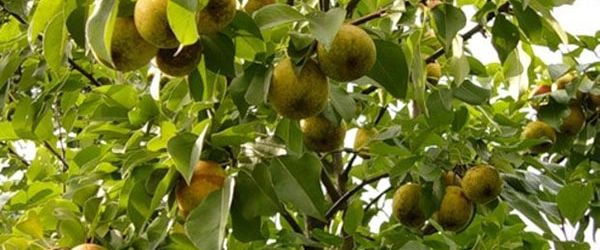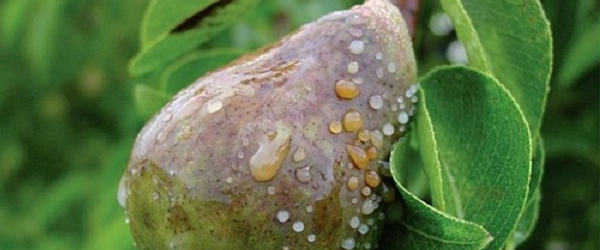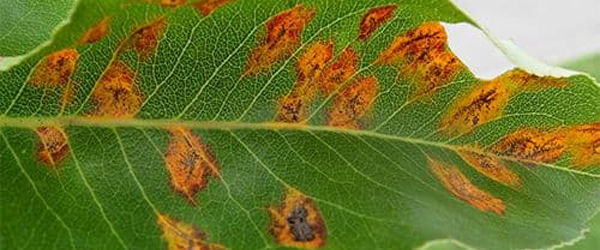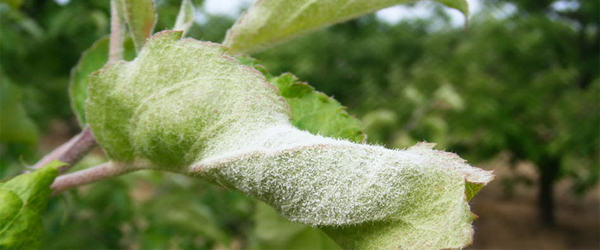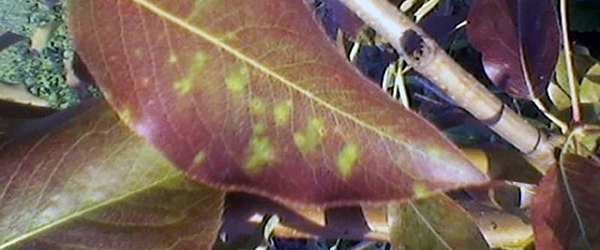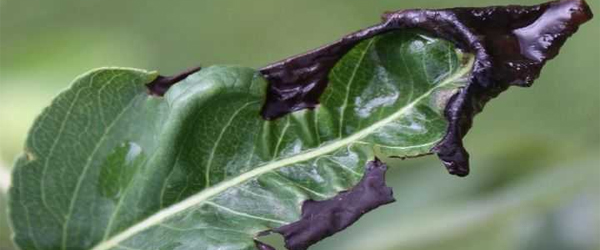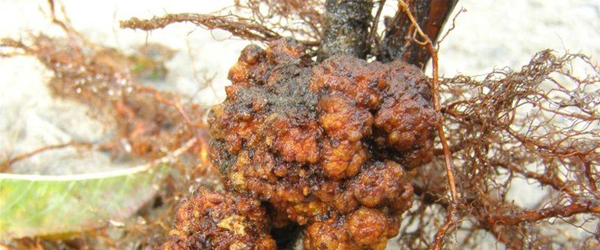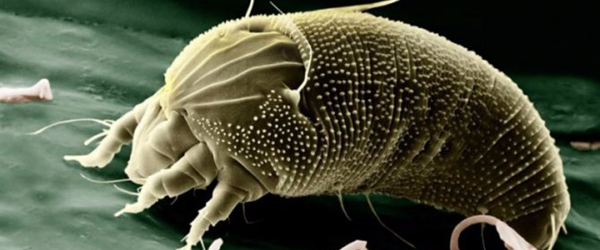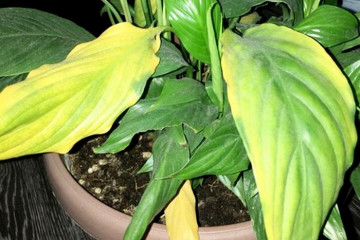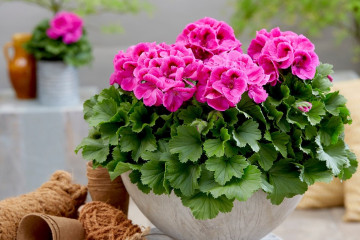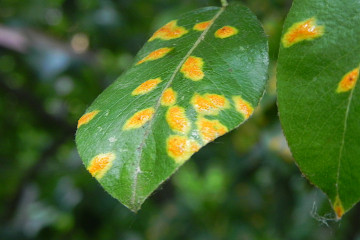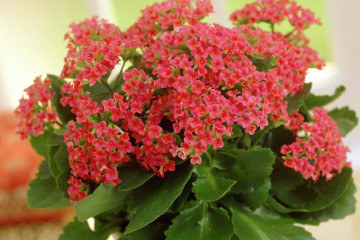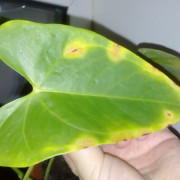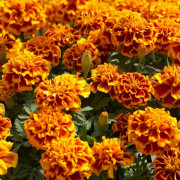Brown leaves on a pear - causes and treatment
Content:
Noticing brown leaves on the pear, the gardener must first cut off and burn the damaged areas of the tree, and in the future acquire seedlings with a strong immune system that can fight for a place in the sun. These experts include Severyanka, Favorite Klappa and Marble.
Why do pear leaves turn brown
Dark brown small specks, which over time can turn brown or black, and subsequently spread over the leaf blade, in most cases turn out to be a parasitic fungus. The infection affects not only foliage, but also fruits and young growth. In the absence of proper care, diseased leaves fall off, and fruits are deformed and lose their taste.
The graft is incompatible with the stock
Incompatibility between scion and rootstock - non-infectious damage. Outwardly, this incompatibility manifests itself as the dwarfism of the terrestrial parts of plants. On the trunk, in the place where the plant was grafted, a shapeless thickening appears. If this area is cleared of bark, a black necrotic line can be seen, and the tissues of the inner part of the scion are affected by necrosis. The foliage of an improperly grafted pear differs from a healthy plant in size - its size is noticeably smaller than that of a full-fledged tree.
Pear viral diseases and their treatment
The pear is susceptible to moniliosis, cytosporosis, brown spot, powdery mildew, milky shine, sooty fungus, leaf rust. The most dangerous are mosaic disease and the so-called witch's broom.
Moniliosis
The causative agents of moniliosis are the fungi Monilia fructigena and Monilia cinerea. Another name for the disease is fruit rot.
Fruits affected by moniliosis are covered with small brown spots. Gradually increasing, the spots spread over the entire surface of the fruit. During the rainy season, fungal spores form on the affected areas, similar to microscopic pads of white-yellow, gray or ash shades.
During dry periods, when the air temperature is very high or low, spores do not form, and infected fruits turn blue-black. During contact of diseased fruits with healthy areas of the tree, the disease quickly spreads along the branches and penetrates into healthy fruits. A tree affected by this disease loses a significant part of its harvest, its inflorescences die, and the young growth dies off.
Cytosporosis
Sporangia of cytosporosis appear as small tubercles or bulges. The disease affects the bark of a tree.The affected areas change in color - become reddish and dry out over time.
Brown spot
Brown spot or phyllosticosis mainly affects apple trees. If the gardener does not take action, the disease will spread throughout the territory. It appears in mid-June: the foliage of the affected tree turns brown in places.
Powdery mildew
Another disease that rarely affects pear trees. A bowl of powdery mildew can be seen on an apple tree. The shoots and foliage of the plant are covered with a powdery white coating - spores and mycelium. As a result, the diseased areas dry out. Flowers affected by powdery mildew become deformed and lose their ovaries. The mycelium can hibernate in infected shoots.
Milky shine
The cause of the appearance of the disease is damage to trees that have not endured the harsh winter. First, the foliage of the diseased tree is covered with a silvery-nacreous tint. At the next stage, tissue death occurs, and then the foliage becomes fragile and slowly dries out. The trunk and branches of a pear affected by a milky sheen acquire a dark color.
Sooty fungus
Diseased areas of the pear tree are covered with black bloom. The sooty fungus affects the surface of foliage, shoots and fruits.
Rye on the leaves
The disease manifests itself as an orange-dark spot of foliage and fruits. Trees adjacent to juniper, the causative agent of "rust", are the first to fall ill.
Mosaic disease
The most dangerous viral disease. It appears as angular, light yellow and pale green spots. Often, the gardener discovers mosaic disease when the pears are ripe. The tree becomes infected with the virus during vaccination.
Witch's broom
It is expressed in the growth of a large number of "wild" thin shoots in the branches of the tree. Growing up, they form a dense, rounded formation. The witch's broom refers to incurable diseases, the trees affected by it must be uprooted and burned.
Chemical treatment
Treating trees with chemicals is the fastest way to protect the garden from viral diseases and invasions of garden parasites.
The fight against moniliosis is reduced to treating pears with fungicides at the beginning of the growing season. Several procedures are carried out with an interval of 1-2 weeks. Experts recommend alternating preparations or using different types of fungicides for each next treatment.
Prevention of cytosporosis consists in harvesting and burning fallen leaves. Fruits affected by the disease are plucked and disposed of like foliage. Infected areas of the tree are disinfected with copper sulfate and treated with clay mixed with mullein.
Brown spot is cured by spraying the tree with Bordeaux liquid or copper oxychloride.
The fight against powdery mildew is reduced to the destruction of fallen diseased foliage and shoots. In the spring, during the period of bud formation, the tree is sprayed with "Fundazol" or sulfur-containing preparations. For 10 liters of water, take 50-100 grams of funds. In warm and humid weather, the treatment is repeated immediately after the end of the flowering season.
To combat milky shine, root and foliar top dressing with urea is used, while spraying the tree with onion peel infusion. The branches affected by the disease are removed and burned. If the measures taken do not help, the tree is uprooted.
Spraying will help to eliminate sooty fungus:
- a solution of 5 g of copper sulfate, 150 g of soap and 10 liters of water;
- Bordeaux liquid solution;
- copper oxychloride.
Prevention consists in preventing excessive soil moisture and thinning the crown, especially in those places where it is running.
The fruits and foliage of pears affected by rye must be burned.Prevention of the disease consists in treatment with a 1% solution of Bordeaux liquid (carried out at the beginning of the flower formation season and after the end of flowering). In September-November, fallen leaves and diseased fruits are burned. Do the same with the affected shoots. In late autumn, a tree completely devoid of foliage is sprayed with a solution of 700 g of urea and 10 liters of water.
Prevention of the disease known as "witch's broom" boils down to disposing of dubious seedlings and disinfecting garden tools. Experienced gardeners recommend:
- prevent the sap of diseased plants from leaking into the environment;
- in the fall, prune the trees touched by the witch's broom, after the branches of healthy trees have been cut;
- do not plant dubious cuttings on obviously healthy trees.
Pear lacks phosphorus
Phosphorus is used to feed the root system. This element is no less important than potassium and nitrogen. A tree that lacks phosphorus does not throw out its buds for a long time and late begins to bloom with rare flowers, its root system does not grow. The fruits of a pear, devoid of phosphorus, have a sour taste.
The foliage of pears and apple trees, lacking phosphorus, develops very slowly, can curl and fade. Old leaves acquire a shade of steel (sometimes bronze), and over time they become spotty, becoming covered with dark, light and yellowish blotches. The fruits of a tree deprived of normal nutrition fall off before ripening.
Phosphorus-containing feeds include superphosphate, bone meal, and phosphate rock. Fertilizers are applied during spring or autumn soil digging. In the summer, from June to August, gardeners spray pear leaves with water-mineral solutions of ammophos, diammophos, ammophos, diammofoska or analogs of these drugs.
Excess lime
Excessive liming of the soil leads to a temporary excess of calcium, as a result of which feeding with other nutrients does not give results. Lime is applied to the soil once - before the start of the garden. Most often, gardeners use ground dolomite flour or limestone mixed with soil intended for backfilling into the planting pit.
Burnt lime is used to feed heavy soils, which are considered unsuitable for planting an orchard. The recommended dose for one feeding is 2.5 kg of substance per 10 sq. meters of soil. The first treatment is carried out before laying the garden, and the second one 3-5 years after planting the trees.
There are brown leaves on the pear: what to do, how to treat
The garden pear is affected by such infectious diseases as fire blight, bacteriosis, root cancer. With a bacterial burn, the infection, spreading through the arboreal vessels, enters the sap of the plant, which leads to the death of tissues and death. Affected trees must be cut down and burned.
The foliage and flowers of the affected pear are treated with antibiotics. The frequency of the procedure is 1 time every 5 days. Dead sections of the crown are cut off, and garden tools are disinfected with a solution of boric acid. By completing the steps just listed, the gardener will prevent the re-spread of pathogenic bacteria.
Bacteriosis that has spread over the pear tree can affect nearby apple trees and wild hawthorns. The characteristic signs of the disease are darkening of the edges of young foliage.Over time, dark areas spread over the leaf blades, petioles and stems.
The fight against bacteriosis consists in the systematic pruning of diseased shoots by 30-40 cm.If the gardener managed to cut off the affected areas before the bacteria penetrated the mother twig or tree trunk, the disease will stop. The surface of the cut branches and garden tools should be disinfected with copper sulfate (3%). Positive results can be achieved by spraying the sections with Bordeaux liquid (1%). Cut damaged areas of the tree must be burned.
Experts recommend a two-stage disinfection:
- Treatment of the kidneys before they swell.
- Processing branches 10 days after the end of the flowering period.
Root cancer
The disease develops under the influence of parasitic bacteria. Its characteristic feature is the proliferation of root tissue or root collar.
The formed growths, sometimes reaching the size of an adult's fist, provoke a violation of the water supply to the roots and their death. As a result, the plant begins to dry out and dies.
Bacteria-causative agents of root cancer live in the soil and penetrate the root system through mechanical damage that appeared during a pick, transplantation of seedlings or after a raid by rodents.
Prevention of the disease consists in discarding damaged seedlings and disinfecting dubious seedlings (the root system of plants is immersed in a 1% solution of copper sulfate for several minutes).
Folk remedies for combating pear diseases
Experienced gardeners combine traditional preventive procedures and methods of treating trees with traditional medicine recipes:
- moniliosis (fruit rot) is cured with iodine solution - 20 ml should be diluted in 2 liters of water;
- to fight fungal infections, 2 liters of water must be added citric acid (100 g) and ferrous sulfate (50 g). Used as a preventive and therapeutic spraying;
- dandelion decoction is used to combat aphids. A kilogram of finely chopped stems are poured with 2 liters of water, infused for 24 hours and brought to a boil. Then add 2 heads of crushed garlic. After thoroughly mixing the ingredients, filter the infusion and mix with a bucket of water in which green soap is diluted (30 g);
- in the spring, pear trees are treated with a product prepared from 20 liters of water, 2 kg of chopped potato tops (infused for 4 hours and filtered) and 2 tablespoons of liquid soap. The resulting solution can scare away pests and prevent diseases;
- the garden is fumigated with a mixture made from straw and tobacco dust. The ingredients are mixed, piled up and set on fire. The smoke emanating from this mixture is harmful to insects, especially to gall mites and ants.
Other reasons why pear leaves turn black
Foliage can turn brown not only due to disease. There are a number of reasons associated with the condition of the soil in the garden, as well as insect pests.
High groundwater table, flooding
The simplest method to lower the water table is to embed surface sand drainage during seasonal flooding and to construct a drainage system in the form of gutters when the water table is constantly high.
The pear is deeply planted
If the root collar of a pear is deepened into the ground, it must be peeled. A recess should be dug around the trunk. Thanks to him, the root collar will always be open. Periodically, this section of the trunk can again be covered with clods of earth. The gardener's task is to monitor his condition, especially after rain. Wet soil stuck to the root collar will provoke rotting.
Experienced gardeners strengthen the hole dug around the root collar with thick blocks of wood so that the edges of the boards rise at least 6 cm above the soil level.The total size of the excavated area should be 140-160 cm.
Preventive treatment of pears from pests and diseases in spring and autumn
The Fruit Moth is one of the most dangerous enemies of pear trees. Moth larvae feed on seeds of early maturing varieties. The fight against the pest is reduced to the timely spraying of trees with pesticides and organophosphorus compounds, digging up the soil in the area of the near-trunk circles.
The hawthorn butterfly, tube worm and leafworm prefer foliage, and the sawyer feeds on ripe fruits. The gall mite is equally dangerous for plants and people.
Orderly spraying will help protect the tree from invasions of garden pests:
- Spring. It is carried out before the buds have blossomed.
- Spraying young foliage. Branches that are already infested with parasites are removed and burned before spraying.
Spraying with industrial insecticides is carried out in goggles and gloves.
The soil in which the pear trees are planted should not be too wet. Excess moisture leads to the development of fungal infections. After cutting off the damaged branches, the gardener must burn them. All questionable parts of the tree are subject to recycling.
